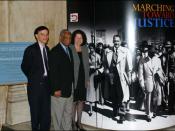The Brown vs. Board of Education of Topeka, Kansas
In the early 1950's, segregation in schools was a normal part of American culture. In Topeka, Kansas, a young African American third grader, named Linda Brown, wanted to enroll in an all white elementary school. The school she was attending at the time, was far away from her home, and this all white elementary school, was just around the corner. However, when her farther tried to enroll her, the Principal quickly denied their wishes. Linda's father was outraged, so he decided to seek help from the NAACP (National Association of Colored People). The NAACP was eager to help the Browns, after all, segregation in schools was a long awaited challenge for them, and they said that the Brown's were the perfect clients. Soon enough, other African American parents joined them and in 1951, the NAACP spoke out.
In the case, the NAACP argued that by separating the black and white students, they were disrupting the idea of "equality".
One of the expert witnesses, Dr. Hugh W. Speer, testified that:
"... if the colored children are denied the experience in school of associating with the white children, who represent 90 percent of our national society in which these colored children must live, then the colored child's curriculum is being greatly curtailed. The Topeka curriculum or any school curriculum cannot be equal under segregation".
The board's defense was that by having segregation in schools, they were preparing the children for segregation in the real world, and this was a way of helping them grow.
The court faced a difficult problem. In their decision they wrote: "Segregation of white and colored children in public schools has a detrimental effect on the colored children... A sense of inferiority affects the motivation of the...



Summary
I would of loved to see more court related issues in the landmark Brown v. Board of Education. Such as, witinesses and defendant's testimonies. With more information on the other similar cases.
However, overall nice way to sum the case up.
0 out of 0 people found this comment useful.